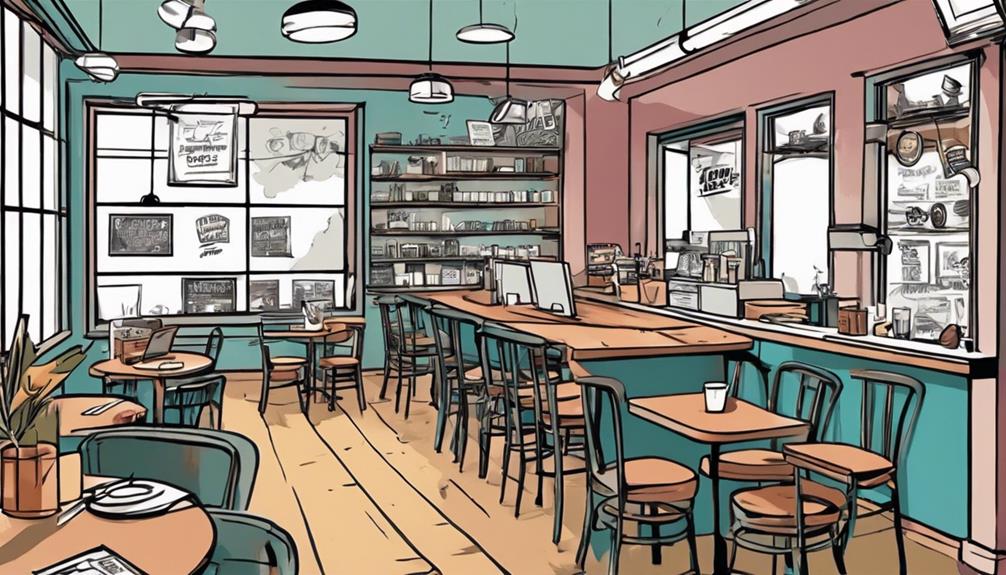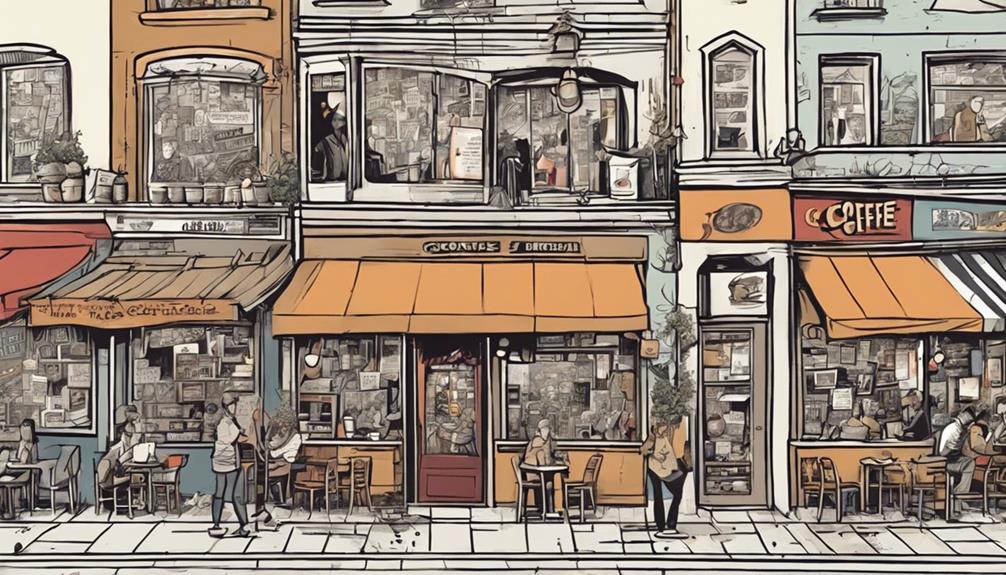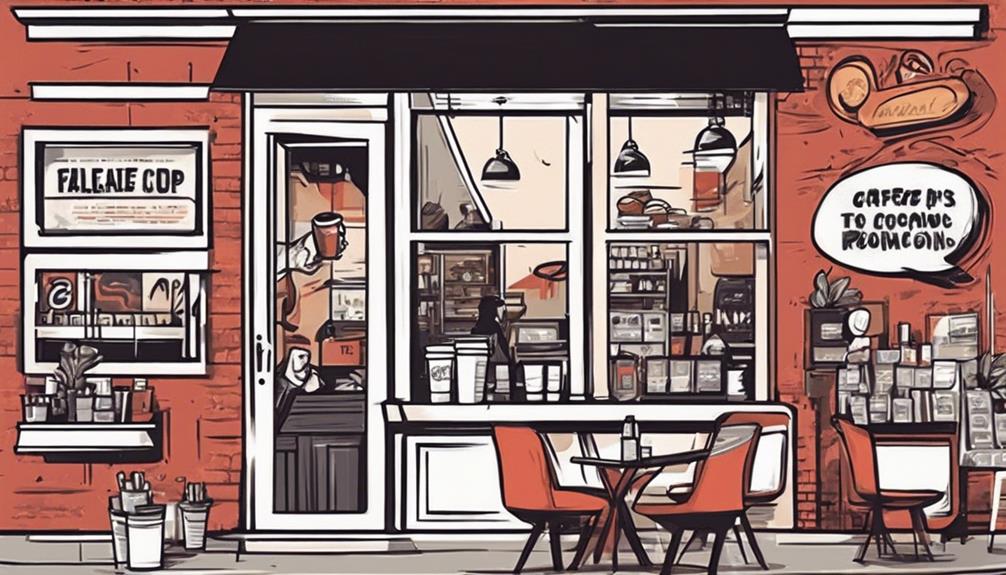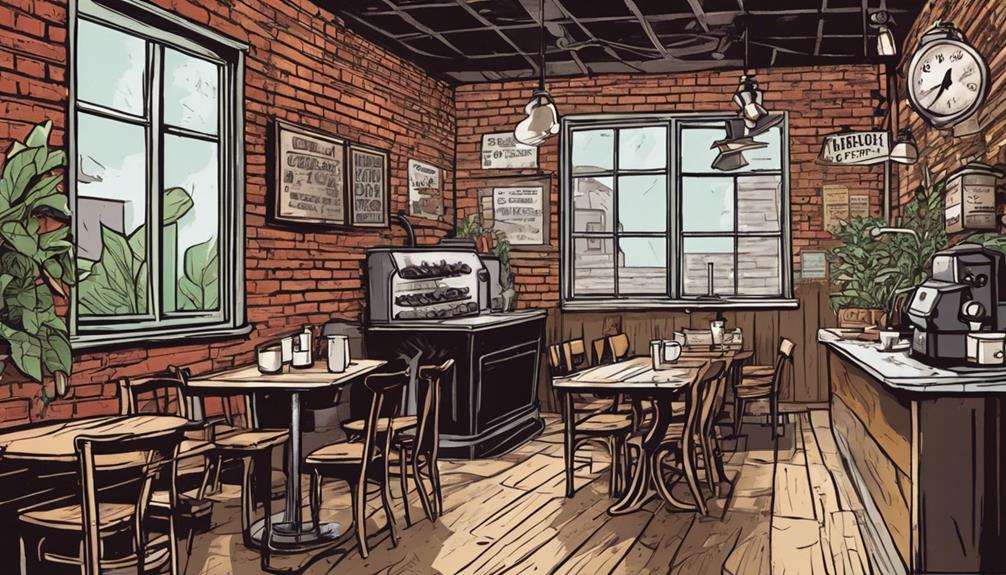To begin building your dream coffee shop from the ground up, start by creating a distinctive brand and locating a spot with high foot traffic. Develop a comprehensive business plan and invest in top-notch coffee equipment. Utilize available resources for assistance and study competitors in order to stand out. Estimate startup expenses, explore funding opportunities, and focus on financial stability. Implement effective marketing tactics to increase brand recognition and interact with the community. Foster customer loyalty through consistent service and utilize social media for visibility. Following these crucial steps will put you on the right track to triumph in the booming coffee shop industry. Consider seeking advice from industry professionals and becoming a member of coffee shop associations to keep up with trends and gain valuable knowledge. Moreover, educate yourself on budgeting strategies for coffee shops to ensure effective financial management and enhance profits. By staying informed and emphasizing financial stability, you can position your coffee shop for long-lasting success in the competitive marketplace.
Key Takeaways
- Conduct thorough market research to understand trends and competition.
- Develop a unique coffee shop concept to stand out.
- Secure a prime location with high foot traffic for visibility.
- Create a detailed business plan outlining costs and goals.
- Invest in high-quality equipment for a successful start.
Market Overview and Growth Trends
With nearly 4% growth in the past year, the coffee shop market in the United States is showing strong potential for new businesses. Entrepreneurs have opportunities to create profitable coffee businesses in this expanding market. Starting from scratch allows you to establish a unique concept without any past entanglements. However, finding the right location and managing costs are essential aspects to contemplate when building your coffee shop.
The growth trends in the coffee shop market indicate a significant increase in the number of coffee shops across the country. Currently, there are approximately 35,616 coffee shops in the United States, with expectations to reach 41,000 by 2023. This growth presents a favorable environment for individuals looking to enter the coffee shop industry and establish their brand.
Advantages and Disadvantages of Starting Fresh

When starting fresh, you have the advantage of creating a brand-new identity and vision for your coffee shop. This flexibility allows you to make decisions tailored to your specific goals and potentially reduce initial costs.
However, challenges such as finding the right location and maneuvering the learning curve of a new business may arise.
Pros of Fresh Start
Starting on a fresh journey when opening a coffee shop provides the opportunity to craft a new brand and concept aligned with your vision. Starting from scratch allows you to establish a new coffee brand and create a unique concept that sets you apart from others in the industry.
With no past entanglements to navigate, you have the freedom in decision-making to shape your coffee shop exactly how you envision it. While inexperienced management may pose a challenge, there's a learning curve that can be overcome with dedication and learning.
Yes, building a coffee shop from scratch can be costly, with expenses like equipment, renovations, and permits adding up. However, the process offers flexibility and the chance to bring your dream coffee business to life.
Embrace the challenges and opportunities that come with starting anew, as they pave the way for a coffee shop that truly reflects your passion and creativity. By embracing the challenges, you can create a space that is uniquely your own and showcases your love for coffee. Use your creativity to design a welcoming atmosphere and craft a menu that excites and delights customers. With dedication and hard work, you can become a successful coffee cafe owner, making your mark in the industry and bringing joy to coffee lovers everywhere.
Cons of Starting Anew
Beginning from scratch when opening a coffee shop presents both advantages and disadvantages in creating a new business venture.
While the idea of starting fresh allows for complete control over the concept and design of the coffee shop, there are significant challenges to bear in mind.
High costs associated with building out a new establishment can put a strain on your budget planning, potentially leading to cost overruns and delays.
Managing a coffee shop without prior experience in the industry can also be overwhelming, as there's a steep learning curve involved in understanding the intricacies of running a successful coffee business.
Additionally, finding the right location for your coffee shop is essential, and this process can be time-consuming and competitive.
These disadvantages highlight the complexities and risks involved in starting anew, emphasizing the importance of thorough research and thoughtful contemplation before venturing into the coffee shop business.
Essential Steps to Launching a Coffee Shop

To successfully launch a coffee shop, make sure you follow these necessary steps. Start by conducting thorough market research to understand the competitive landscape and customer preferences.
Develop a unique coffee shop concept that will differentiate your business from others in the market. Securing a prime location with high foot traffic is vital to attract a steady flow of customers to your establishment.
Create a detailed business plan that includes financial projections, marketing strategies, and operational processes to guarantee a smooth launch and sustained success.
Investing in high-quality coffee equipment and supplies is vital to ensure a top-tier customer experience and uphold the standards of your coffee shop.
Setting Up Your Coffee Shop: Equipment and Legalities

Guarantee the success of your coffee shop by investing in quality coffee equipment and handling the necessary legalities for your business setup. To ensure high-quality coffee production, equip your shop with top-notch espresso machines, grinders, and brewers. Create a detailed coffee equipment checklist to make sure you have all the essential tools for your setup. In addition, develop a comprehensive business plan outlining your equipment needs, budget, and operational processes. Determine your coffee shop costs and break-even point to grasp the financial aspects of launching your business. Simultaneously, establish a legal business structure and collaborate with county and city agencies to secure the required permits and licenses for your coffee shop.
| Coffee Equipment Checklist | Legalities and Business Setup |
|---|---|
| Espresso Machines | Legal Business Structure |
| Grinders | Permits and Licenses |
| Brewers | Operational Processes |
Startup Resources for Coffee Shop Owners

Consider utilizing accessible resources and support to enhance your coffee shop startup journey. Aspiring coffee shop owners can kickstart their venture by using thorough guides and tools specifically designed to assist in beginning a coffee business.
A good starting point is to explore a coffee shop planning kit, which can streamline the startup process and provide valuable insights. These resources offer a wealth of information and support, tailored to navigate the complexities of opening a coffee shop from scratch.
Opting for a complete coffee shop startup kit can further guarantee a smoother launch, providing you with the necessary framework to succeed. By exploring the benefits of these resources, you can better equip yourself for the challenges ahead and increase your chances of establishing a thriving coffee shop.
Make the most of the available resources to set yourself up for success in the competitive coffee shop market.
Market Analysis and Competition Strategies

You need to grasp the local coffee market dynamics and investigate your competitors to carve out your unique selling points.
By strategically positioning your business, you can effectively differentiate yourself in a crowded market.
Choosing the right location and understanding your target customers will further boost your competitive edge.
Competitive Market Analysis
In order to successfully establish a competitive advantage in the local coffee market, it's imperative to conduct a thorough analysis of market trends and competition. By delving into local coffee market trends, understanding customer preferences, and evaluating competitor strengths, you can develop a unique positioning strategy that sets your coffee shop apart.
Evaluating market saturation and the demand for specialty coffee will give you insight into the potential success of your venture. Selecting a strategic location that considers factors like foot traffic, demographics, and competitor presence is vital. Additionally, focusing on target customer orientation and precise market positioning will help your coffee shop stand out in a crowded marketplace.
Strategic Positioning Strategies
To gain an advantageous edge in the local coffee market, explore market trends and competition to define your coffee shop's strategic positioning. Start by analyzing customer preferences and conducting a local market analysis to understand what sets your competitors apart.
Highlight your unique offerings and identify your target market to tailor your branding and marketing strategies effectively. When conducting a location analysis, consider factors like foot traffic, demographics, and competitor proximity to position your coffee shop strategically.
Competitor analysis plays an essential role in shaping your differentiation strategies. Identify your competitors' strengths and weaknesses to capitalize on opportunities that set your coffee shop apart. By defining your strategic positioning based on a thorough understanding of the local market and competition, you can create a compelling value proposition for your target customers.
Financial Planning and Business Setup

Financial planning and business setup for a coffee shop are essential steps in ensuring long-term success and profitability. Before diving into the exciting world of coffee brewing, it's important to take into account the financial aspects. Starting costs for a coffee shop typically range from $60,000 to $300,000, encompassing expenses like real estate, equipment, and marketing. To kickstart your venture, explore funding options such as personal capital, investors, or small business loans. Prioritize budgeting and financial sustainability, using tools like business plan templates and the Restaurant Opening Calculator for guidance. Additionally, implementing accurate accounting practices is crucial for tracking expenses and profits effectively.
When it comes to pricing strategies, stay adaptable to market trends to maintain profitability. Below is a table summarizing key aspects of financial planning and business setup for your coffee shop:
| Aspect | Key Points |
|---|---|
| Financial Planning | Estimate startup costs, seek funding options |
| Budgeting | Prioritize financial sustainability |
| Pricing Strategies | Review and adjust prices according to market trends |
Marketing, Branding, and Customer Engagement

Explore innovative marketing strategies and effective branding techniques to enhance customer engagement and boost your coffee shop's visibility in the competitive market.
Implementing a strong marketing strategy is essential, as word-of-mouth recommendations drive 82% of customers to coffee shops.
Engage with the local community through events and partnerships to increase brand awareness and loyalty.
Utilize digital platforms like social media and email marketing to reach a broader audience and drive customer engagement.
Offering promotions and discounts can attract new customers and encourage repeat visits, influencing 65% of consumers' purchasing decisions.
Building brand awareness and loyalty is pivotal for long-term success, as 48% of consumers stay loyal to brands providing consistent experiences.
Frequently Asked Questions
How to Start a Cafe Business From Scratch?
Starting a cafe business from scratch requires meticulous planning and market research. Choose a unique concept, prime location, and quality ingredients. Secure funding, invest in equipment, set competitive prices, focus on branding, and stay updated on industry trends.
How Profitable Is Owning a Coffee Shop?
Owning a coffee shop can be profitable, with margins averaging 2.5% to 6.5%. Success depends on location, competition, operational efficiency, and customer loyalty. Specializing in premium coffee can boost profits through higher pricing and loyal customers.
How Much Does It Cost to Set up a Coffee Shop?
So, you're curious about the cost of starting a coffee shop? Well, buckle up! Setting up a café can run you anywhere from $60,000 to $300,000, depending on factors like location and size. It's a pricey brew, my friend!
How to Build a Cafe Shop?
To build a cafe shop, you must develop a unique concept, design a functional layout, source high-quality ingredients, create a diverse menu, and implement effective branding. With dedication and creativity, you can create a successful coffee shop.
Conclusion
To sum up, building a coffee shop from scratch can be a rewarding journey filled with endless possibilities. Remember, Rome wasn't built in a day, so take your time to craft a unique experience for your customers.
Just like a freshly brewed cup of coffee warms the soul, your dream shop has the potential to make a lasting impact in the community.
So go ahead, take that leap of faith and let your entrepreneurial spirit soar!









